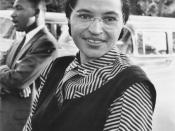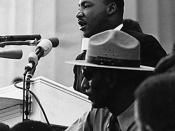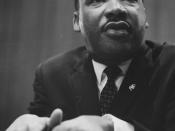Since before the founding of America, whites have considered themselves to be superior to blacks. After the Civil War, blacks were no longer kept as slave, but they still did not receive equal treatment or respect as whites. In the mid 1900's, the Civil Rights Movement fought for true liberty, the fullest intent of the Declaration of Independence and the Constitution, and ultimately succeeded in securing equality through demonstrations, influential leaders and court rulings.
Marches, sit-ins and boycotts made up most of the peaceful demonstrations. The majority of the marches held focused on a common goal: to get equal voting rights for blacks. In March 1965, Dr. Martin Luther King Jr. led a march from Selma to Montgomery, Alabama. But they were attacked by the police and turned back. When they tried once more, two days later, the police once again stopped them. President Lyndon B. Johnson ordered the police not to interfere with the march, and on March 21, 1965, and 20,000 people, blacks and whites, began a four-day journey towards change.
The news and publicity of the essentially successful march motivated the Congress to pass the Voting Rights Act, which allowed blacks to register to vote without needing to pass a qualification test. Within one year, the number of blacks registered to vote nearly doubled. In August 1963, one of the largest demonstrations in American history took place: the march on Washington. The main purpose of the march was to put pressure on Congress to pass President Kennedy's new civil rights bill. Kennedy urged against the march, fearing a hostile response in Congress, but on August 28, over 200,000 blacks and whites both gathered before the Lincoln Memorial to hear Dr. Martin Luther King speak. After the death of President Kennedy, President LBJ urged the bill through Congress...


